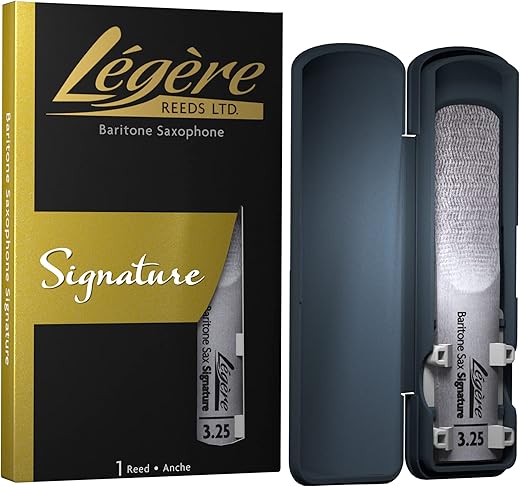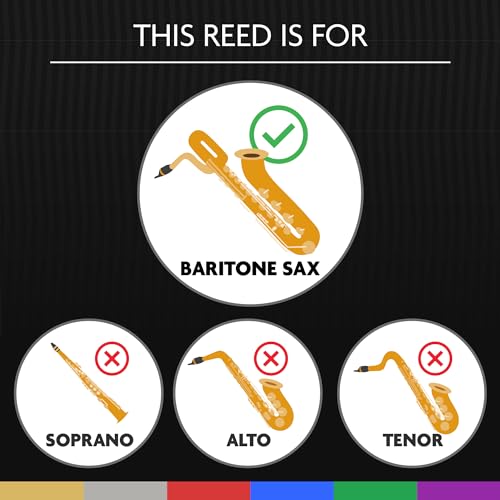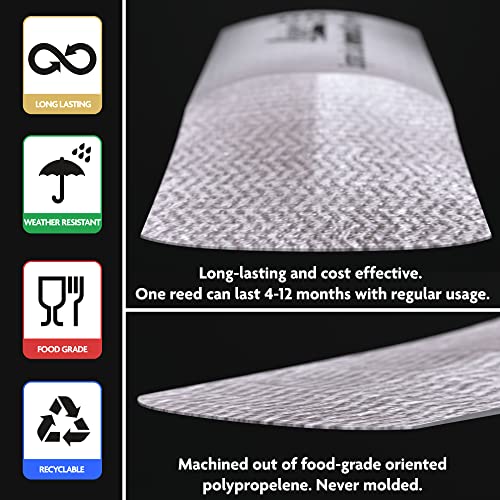Legere Baritone Saxophone Reed, Strength 3.25 (BSG3.25)

€38.99 Original price was: €38.99.€36.95Current price is: €36.95.
Legere Baritone Saxophone Reed, Strength 3.25 (BSG3.25) Price comparison
Legere Baritone Saxophone Reed, Strength 3.25 (BSG3.25) Price History
Legere Baritone Saxophone Reed, Strength 3.25 (BSG3.25) Description
Discover the Legere Baritone Saxophone Reed, Strength 3.25 (BSG3.25)
Elevate your music experience with the Legere Baritone Saxophone Reed, Strength 3.25 (BSG3.25). Designed specifically for intermediate and advanced players, this reed offers superior performance, consistent sound quality, and comfort. Whether you’re playing in a jazz band, concert, or solo, this reed will enhance your tone and bring your music to life.
Main Features and Benefits of the Legere Baritone Saxophone Reed
- Premium Material: Crafted from food-grade polypropylene, this reed is durable and withstands the rigors of regular performance. Unlike traditional cane reeds, it won’t warp or degrade, ensuring long-lasting playability.
- Strength 3.25: The Legere BSG3.25 is designed for those who prefer a bit more resistance. It strikes a balance between power and control, making it perfect for expressive playing styles.
- Transparent Design: Its unique transparent material allows for a clear view of your reed setup, enhancing your confidence during performances. It’s as functional as it is aesthetically pleasing.
- Consistent Performance: Musicians often struggle with the variability of cane reeds. The Legere reed provides a uniform performance every time, allowing for dependable tone and intonation.
- Lightweight and Portable: Weighing only 0.32 ounces and measuring 4.5 x 2.75 x 0.44 inches, the Legere reed is easy to carry in your instrument case, making it a convenient choice for musicians on the go.
Price Comparison Across Suppliers
When evaluating the Legere Baritone Saxophone Reed, Strength 3.25, pricing can vary across different suppliers. On our price comparison platform, users can find competitive prices that range from $15 to $25. This diverse pricing spectrum allows musicians to select the best offer that suits their budget. Regularly check our site to ensure you get the best price available.
6-Month Price History Trends
The 6-month price history chart reveals an interesting trend for the Legere BSG3.25. Last year, the prices fluctuated significantly, but recently, a notable decrease in price is observed. This trend makes it an ideal time to invest in high-quality reeds without breaking the bank.
Consumer Reviews: Celebrating the Pros and Cons
Customer feedback on the Legere Baritone Saxophone Reed highlights a variety of user experiences. Many reviewers praise the reed for its rich, full-bodied tone. The durability of the food-grade polypropylene material is a favorite feature, as it minimizes the need for frequent replacements. Musicians appreciate the consistency the reed offers, particularly during live performances.
However, some users note that the strength may feel a bit stiff for beginner players. Those new to playing the baritone saxophone may want to consider a slightly lower strength for optimal comfort. Overall, the positive reviews far outweigh the negatives, making this reed a solid choice for anyone serious about their craft.
Explore Unboxing and Review Videos
For those seeking a deeper understanding of the Legere Baritone Saxophone Reed, Strength 3.25, there are numerous unboxing and review videos available on YouTube. These videos showcase the reed in action, detailing its features and offering firsthand accounts from players. Viewing these videos can provide valuable insights into how the reed performs in real-world scenarios.
Final Thoughts
In summary, the Legere Baritone Saxophone Reed, Strength 3.25 (BSG3.25) is an excellent investment for intermediate and advanced players. Its premium material, consistent performance, and convenient design make it a top choice in today’s market. By utilizing our price comparison feature, you can easily find the best deal available. Don’t miss out on elevating your musical experience!
Compare prices now!
Legere Baritone Saxophone Reed, Strength 3.25 (BSG3.25) Specification
Specification: Legere Baritone Saxophone Reed, Strength 3.25 (BSG3.25)
|
Legere Baritone Saxophone Reed, Strength 3.25 (BSG3.25) Reviews (13)
13 reviews for Legere Baritone Saxophone Reed, Strength 3.25 (BSG3.25)
Only logged in customers who have purchased this product may leave a review.












R. Howell –
I have used synthetic reeds on my Selmer Bari for years. Generally I used Fibrecell and they are fine quality. All synthetics are a little different, just like a cane reed, and you need to find one that fits. So, I decided to switch to the NEW Signature series. It responds like cane, is a little less vibrant than the Fibrecell and BARI. It works great on my Berg. NOTE: these reeds run hard for me and I ordered a 2 (normally play a 3 or MH) and it was fine. Other variations of Legere have NOT worked for me but the SIGNATURE is a different animal.
Kurt E. –
First off, this reed is not so good as the best natural reeds I have played; however, it is definitely better than the average of a box of a dozen. I would say typically 1 or 2 reeds in a 12 pack equal or better this reed!
I am an amateur played in a couple of New Horizon Big Bands – getting 10 hours a week of sax time, and this reed works well for me and many of the guys I play with. I let my instructor (who is internationally known, gets a minimum of 8 hours sax time every day!) try one and he was impressed with the overall “playability” of it, but it did not convert him from using natural reeds. He knows how to salvage some of the natural reeds, and also does more stuff like harmonics/altissimo and growls, etc. Whether he is just used to how a natural reed behaves or if the natural reed is more capable I cannot guess.
However, for me, this solves many problems. The Benefits for me:
1) Consistency between reeds. I won’t say every reed plays exactly the same but they are extremely consistent compared to natural reeds!
2) Always ready to go!
2) a) I am “schedule challenged” and not having to wet the reed to get it past the warp before playing is a big plus.
2) b) The same goes for practicing at home. I leave my sax on the stand and it is much easier to pick it up and play when I have 15 minutes free when I know I can immediately begin playing!
2) c) Doesn’t apply too me, but some of my friends double, playing sax with an occasional clarinet part. They find putting a Legere Signature reed on their clarinet just makes life easier!
I have been playing these reeds for over 3 years and here are some tips I think will help the next guy:
1) Subtract 1/2 to 3/4 from the natural cane reed hardness! I play a #3 natural reed and found the Legere #2-1/4 to be the best match. More recently, I have started playing a #2-1/2. I assume (and like to think) that is because I am getting better and more aggressive in my playing, but I would advise anyone to buy at both 1/2 and 3/4 below your cane reed preference to see which is better for you. Legere has a return policy that allows you to swap reeds while determining your correct number. Go to the Legere website to get details. I am not positive that Amazon orders will adhere to this policy – probably so, but make sure!
2) Buy a second as soon as you determine what number. So, if you tried 1/2 and 3/4 below your normal and returned one, you should now have two of these, so this is covered! The reason it is important to have a second reed is it is the only sure way to determine if the reed you are playing is getting worn out. Essentially, the reed gets softer as it is played. I have not kept track, but would guess I get about 6 months out of a reed. Of course the change is gradual and I subconsciously adjust my embouchure to match the reed. Eventually, I realize I am struggling to pop out a high note (on Bari Sax) and impress myself with how gently I can get a low A to speak at pianissimo levels! That is my clue that the reed is getting past its prime. However, I find a better approach is to have a new reed available for comparison and any time I have a major gig coming up, I will throw on the new reed to see if I like it better! If you are really thrifty, you can switch back to the old reed after your gig (considering it a “practice reed”), but I usually toss the old reed in the trash because otherwise I end up with a collection of old reeds that I will never play again!
3) Break-in the reed! I have no way of knowing if this is real or just psychological, but it seems to me like spending a few minutes with a fresh synthetic reed blasting out low notes helps loosen up the reed. It makes sense in keeping with how the reed changes over months of use, and it seems reasonable that the first few minutes of play on a reed that has not yet been flexed is liable to change the properties. I feel this gets it past those first changes of break-in into a more stable reed for the coming months. I also want to do this before comparing it with an older reed (item 2 above).
4) Soften sharp corners. I don’t know why, but every now and then I’ll get one of these where the edge of the reed is sharp and feels like it is cutting my upper lip on either side. This would never happen with a cane reed because natural rood fibers are rounded. If this happens you want to gently soften the corner. Obviously you do not want to change the reed much and it only takes a small change to fix this. Probably the safest way to do this is with some 200 or higher (finer) grit sand paper. Do not press (you are only wanting to alter the tiny edge of that corner of the plastic reed). Give it two light strokes straight down (not across!) the sharp edge of the reed. That should do it, but test it to be sure.
Another technique for this:
I usually don’t have sandpaper handy, so I usually take a razor sharp knife or box cutter and turn the blade 90 degrees to the reed and lightly slide it down the edge. You probably won’t even see the plastic coming off (if you did, it would be a “wisp”), but one pass should do it. The trick here is to a) keep the blade right at 90 degrees so it doesn’t try to dig into the plastic, and b) use a very light touch so there is no “chatter” as the blade slides along the corner!
ROB JONES –
Fantastic quality reed for Bari sax, great sound from these Legere reeds. Can’t fault them at all.
Patrice ANTRAS –
Produit tout à fait conforme à la description
Brad Nichols –
So, you will have to find the right one for your situation. They sound great, once you get used to the way they play. They always work. They never dry out. They don’t care about humidity or temperature. They just work. It’s a great way to test to see if there is something wrong with an instrument or a traditional reed because they are that predictable and reliable.
Astarfishnamedleroy –
I play on a Jody Jazz Jet 7 and these reeds in a 2.75 work great for me. Lasts forever and sound the same every time!
John Sparrow –
Always dependable
scott –
This is a great value for the money. The sound quality is still excellent. My son prefers these over all others.
Liz jensen –
It’s so good especially if you are in marching band
Cliente de Amazon –
Me encanta!!!
Emilio Horta –
I play bari in a community band that practices together once a week for a few hours and then I practice on my own a few hours a week as well. That said my traditional reeds were warping quickly due to moisture and drying and I was wasting a lot of money on new reeds. I decided to try these and they sound almost identical to my normal reeds, they play incredibly easily and don’t require prep. They are a bit harder on the mouth, but that is quickly adjusted for. Quality is great, it looks like a normal reed but clear. If you bump something you don’t need to worry if your reed chipped which is also nice. The only downside you’ll notice is having to empty your spit valve as these don’t absorb water.
J Johnston –
I will always order the same make
fausto –
pronta all’uso, sempre, resistente, ma sempre con cautela. Costa un pochino, ma se non altro la resa è stabile rispetto a quelle di legno.